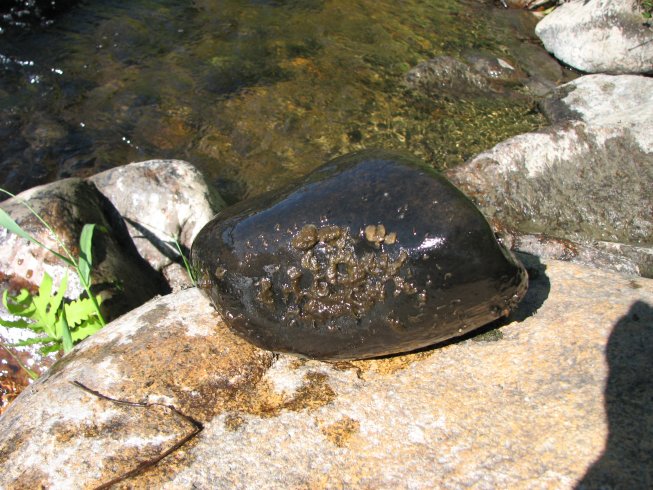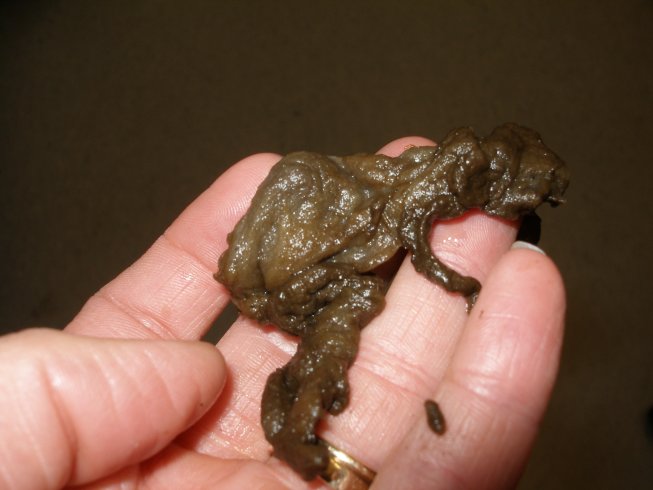|
It appears that our war with invasive weeds and algae polluting and destroying our waters are long from being over. The New Hampshire Department of Environmental Services recently issued an alert that the invasive algae
"Didymosphenia geminate", which is also known disgustingly as "Rock Snot" or
Didymo, has been encountered along the northern reaches of the Connecticut River, as well as in the White River near Bethel, Vermont. A local fishing guide discovered this invasive algae, which was later confirmed by the Vermont Natural Resources Agency. This is said to be the first positive identification of this algae in the northeastern region of the United States.
Because of its extremely invasive nature and the close proximity of the findings to New Hampshire, it is imperative that scientists and experts from across the region address the threat of further spreading of this algae into other
water bodies. According to the Environmental Protection Agency, this algae is the only freshwater diatom to exhibit large scale invasive behavior. It impacts infested
water bodies significantly with the ability to greatly alter food web structure, as well as the hydraulics of streams and rivers.

Didymosphenia geminate (Photo
courtesy of NH Department of Environmental Services)

Didymosphenia geminate (Photo
courtesy of NH Department of Environmental Services)
In other rivers that have been invaded by "Didymo", there have been accounts of large blooms forming thick mats of cottony material on stream and river bottoms. These mats can, and do, suffocate aquatic plants and obliterate fish habitat. Dense mats of Didymo can greatly harm populations of aquatic insects, which form a very important source of food for fish, including trout.
"The devastation to the habitat of our New Hampshire streams and rivers by Didymo may be as destructive as exotic milfoil is to our lakes and ponds," says Judy Connor, the DES Limnology Center Director. "New Hampshire biologists are extremely concerned and are taking the threat of the spread of Didymo to our rivers and streams very seriously."
Currently, there is no way to control or eliminate Didymo, which is why the prevention of further spread of this algae is imperative. According to Steve Couture, DES Rivers Coordinator,
"This invasive diatom could have potentially significant ecological impacts to New Hampshire’s invaluable river and stream resources." DES stresses that the following precautions must be adhered to by all recreationalists, boaters, paddlers and anglers, to help stop the spread of Didymo to other rivers and streams by using the following check, clean, dry protocol:
-
CHECK - Remove all visible clumps of algae and plant material from your boat, motor, fishing gear, waders, clothing, water shoes, sandals, canoes and kayaks and anything else that has been in the water.
-
CLEAN - Soak and scrub all items for at least 10 minutes in very hot water (140 degrees) with lots of soap. Felt-soled waders need 30 minutes soaking.
-
DRY - Whenever possible, dry all items thoroughly for at least 48 hours before using them in another
water body.
There are numerous questions one may have concerning Didymo, to which the New Hampshire Department of Environmental Services has answers. Here are a few questions with their answers:
-
What is
Didymo?
It is the common name for Didymosphenia geminata, an evasive freshwater diatom species (microscopic algae). Didymo can form extensive blooms on the bottoms of rocky river beds, essentially smothering aquatic life forms such as macro invertebrates (aquatic insects), native algae and other organisms. Additionally, the physical appearance of the bloom is aesthetically unpleasing and can reduce the recreational values of a
waterbody. Didymo uses stalks to attach to rocks and plants in a river system. The diatom creates these stalks, which can form masses 10 to 12 inches thick on the river bottom ands trail for lengths of 2 to 3 feet in the current. It is actually these stalks that are more problematic than the algae. The algae will eventually die off and decompose, while these stalks tend to persist for several months on the river bottom.
-
Where did it come from?
Didymo is generally a northern circumpolar species found in colder, low nutrient, high clarity streams. We are noticing a shift in the habitats where Didymo can survive now to include streams in warmer climates, streams with more nutrients, streams with moderate clarities and even some tannic (tea colored) waters. Didymo is currently found in
Europe (Scotland, Poland) and is spreading throughout the northwestern region of the United States. It is also in Quebec and British Columbia. New Zealand has been particularly hardest hit by the Didymo problem. We believe that Didymo was introduced to this region by contaminated fishing/wading gear.
-
Why is Didymo a Problem?
Because it will change the bottom appearance structure and food web of a stream. Ecologically, common macro invertebrates found on the bottoms of well-oxygenated streams will change to more worm-like and snail populated communities. Aesthetically, the brownish-white flowing masses of the stalk structures are unpleasant to see and less enjoyable for the recreation public.
-
What is the current distribution of Didymo in the northeast region of the U.S.?
Currently, portions of the Connecticut River near Bloomfield, Vermont are infested, as are portions of the White River in Vermont, downstream of the Stony Brook confluence. Due to the nature of the spread, biologists are concerned that any areas downstream of these two rivers could eventually show growing colonies of
Didymo. Reports from far northern New Hampshire, in the Connecticut Lakes Region, suggest that Didymo may be growing there as well, but this has not been confirmed at this time.
-
What does Didymo look like?
Didymo is often described as looking similar to a sewage spill in a waterbody, where wet toilet paper is streaming in the flow. This is the result of the stalk material becoming long and shredding at the ends and bleaching white. These mats have a slimy appearance, but are not actually slimy. Over time, the bloom may take on a brownish, flocky appearance due to the fact that sediment particles may become embedded within the stalks.
-
What does Didymo feel like?
It feels like wet felt, wool, or cotton balls. It is hard to pull apart and hard to remove from the substrate it has attached to. In contrast, most other algae species feel slimy and will slip through your fingers.
-
Does it smell or have an odor?
Generally, no. There is no distinctive odor or smell associated with the algae or the stalk material.
-
In what types of habitats or conditions is Didymo generally found?
It is found in river systems with stable substrates such as cobble or rock bottoms. Water conditions are usually clear, cool (optimal temperature is about 60 degrees F), have high light penetration and lower
nutrient concentrations. Flow conditions are generally moderate to moderately fast.
-
How is Didymo spread?
This algae is so small it can go unobserved when it is a single algal cell on the bottom or in a stream column. Additionally, the algae can remain viable for several weeks if kept moist. Because of this, spread of the algae is unfortunately easy. Felt-soled waders are often particularly to blame, since anglers use them to gain a grip on slippery rocky bottomed areas. The algae easily becomes attached to the felt and, if not properly cleaned or thoroughly dried before use, the diatom can spread to another waterbody. Any other recreational equipment, including bait buckets, diving gear (neoprene), water shoes and sandals, canoes, kayaks and life jackets, to name a few that can be carriers from place to place.
-
Will we ever get rid of it?
There is no means of eradication for this algae. Copper sulfate complexes can be used, but they are not 100% effective. Some algae will survive and float downstream and form new colonies.
-
Can Didymo grow in lakes?
Yes, since Didymo is an algae it certainly can grow in lakes and ponds or other freshwater systems. Didymo generally will not reach bloom conditions in these types of systems but, they will most certainly be a problem in river systems.
-
What do I do if I think I saw Didymo?
First, consult the link on the Didymo page at www.des.state.nh.us/wmb/exoticspecies that is called "How To Tell If You May Be Seeing Didymo" to determine if the specimen is worth collecting. If yes, then collect a representative sample of what you are seeing and send it to the New Hampshire Department of Environmental Services, P.O. Box 95, Concord, N.H. 03302-0095. If in doubt, send the sample collected anyway. Be sure to explain exactly where you found it.
For further information about Didymo, readers can call the NHDES in Concord, N.H. at: 603-271-2248.
|



